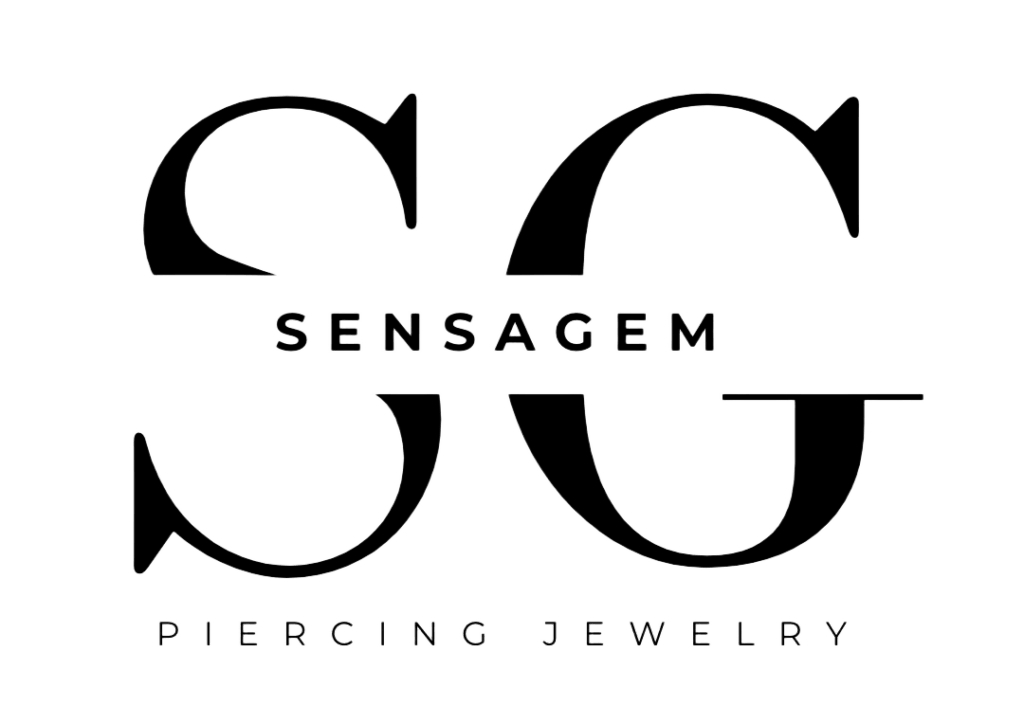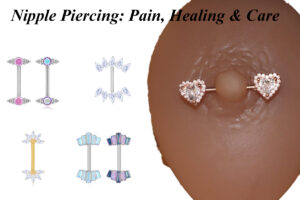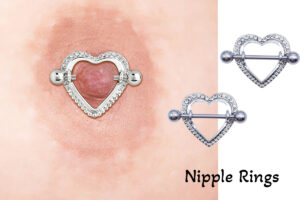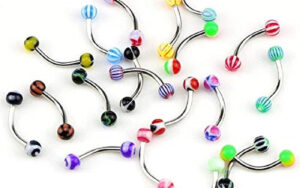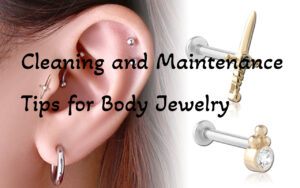I. Einführung
Tongue piercings have long been a prominent form of body modification, symbolizing various cultural, spiritual, and personal expressions. From ancient rituals to contemporary fashion statements, the practice has evolved significantly over time. In diesem Artikel, we will explore the rich history of tongue piercings, examine the various types available today, and discuss suitable jewelry options and gauge sizes.
II. The History of Tongue Piercing
Ancient Practices
The origins of tongue piercing can be traced back to ancient civilizations, where it held profound ritualistic and spiritual significance.
Maya Civilization: In Mesoamerican cultures, particularly among the Maya, bloodletting was a central ritual performed by the elite to communicate with deities and royal ancestors. This practice involved piercing various body parts, including the tongue, to offer blood as a sacred gift. The act of bloodletting was believed to maintain cosmic order and ensure agricultural fertility.
Aztec Culture: Similarly, the Aztecs engaged in tongue piercing as part of their ceremonial practices. Priests would pierce their tongues to draw blood, which was considered a potent offering to appease and honor their gods. This ritual underscored the deep spiritual connection they sought with the divine.
Australian Indigenous Tribes: Certain Indigenous Australian tribes also practiced tongue piercing during spiritual ceremonies. These rituals were often associated with initiation rites and were believed to facilitate communication with ancestral spirits. The act of piercing was part of broader practices aimed at accessing altered states of consciousness.
Modern Revival
The resurgence of tongue piercing in contemporary culture can be attributed to several key developments:
Early 20th Century: Western fascination with body modification practices from other cultures led to the incorporation of tongue piercing into sideshow performances. Performers, inspired by Fakirs from the Middle East and Asia, showcased tongue piercing as a form of entertainment, introducing the concept to American and European audiences.
Post-World War II Era: Following World War II, body piercing began to gain popularity in Western subcultures. The establishment of professional piercing studios during this period played a crucial role in promoting tongue piercing. These studios emphasized safety standards and provided a space for individuals to explore body modification as a form of self-expression.
Late 20th Century: The 1970s and 1980s witnessed a broader acceptance of body piercings, including tongue piercings, within various subcultures such as the punk movement. This era marked a shift towards viewing body modification as a legitimate form of personal and artistic expression.
III. Understanding Tongue Piercing Jewelry
Selecting the appropriate jewelry for a tongue piercing is crucial for ensuring comfort, promoting healing, and expressing personal style. This section delves into the various types of tongue piercing jewelry, their dimensions, and customization options.
Basic Jewelry Types
Gerade Hanteln: The most common and preferred style for tongue piercings. They consist of a straight metal bar with threaded balls or decorative ends on both sides. This design minimizes movement and reduces the risk of dental damage.
Gebogene Hanteln: Featuring a slight curve, these are occasionally used depending on individual anatomy and specific piercing placements. Jedoch, they are less typical for standard tongue piercings due to potential discomfort and increased movement.
Rundhanteln (Horseshoe Barbells) and Captive Bead Rings: Rarely used for tongue piercings, these styles are more about aesthetic preference. They can increase the risk of tooth and gum damage due to their shape and movement within the mouth.

Gerade Hanteln
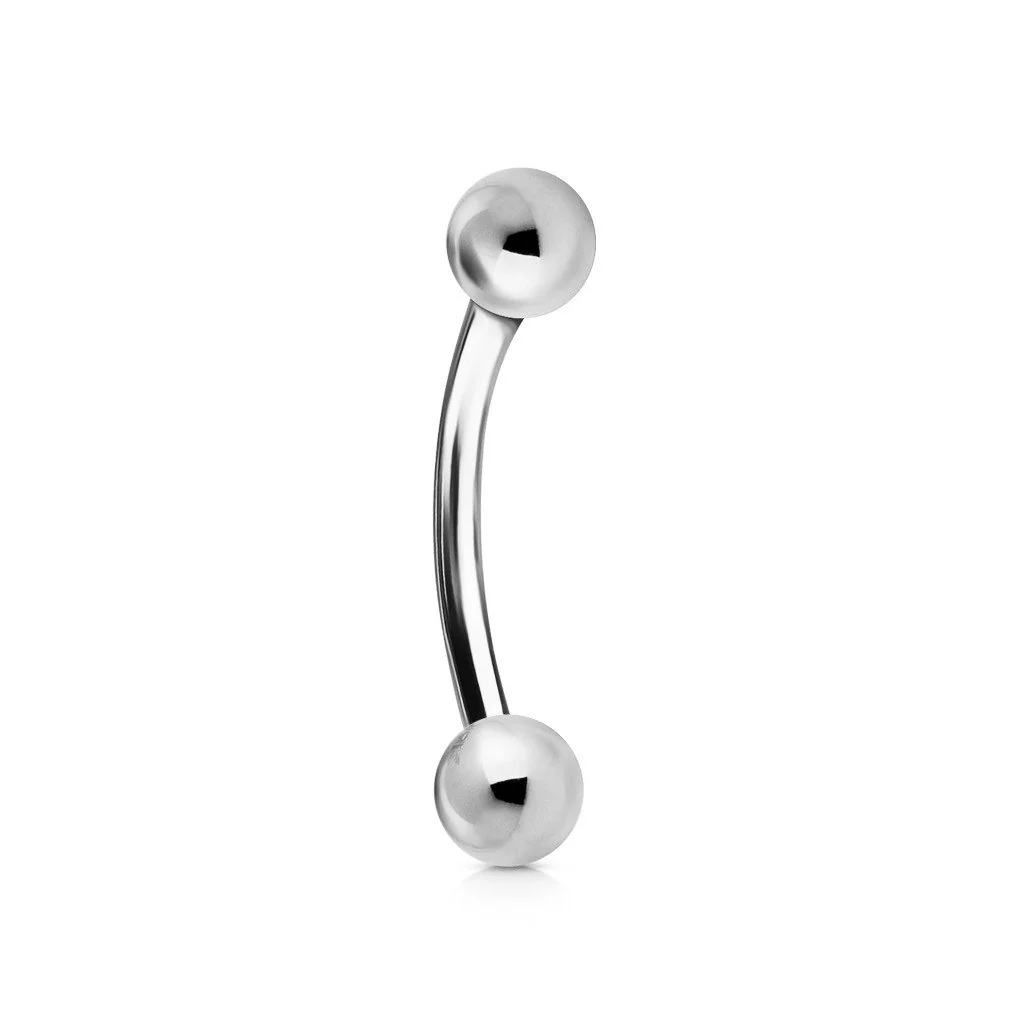
Gebogene Hanteln
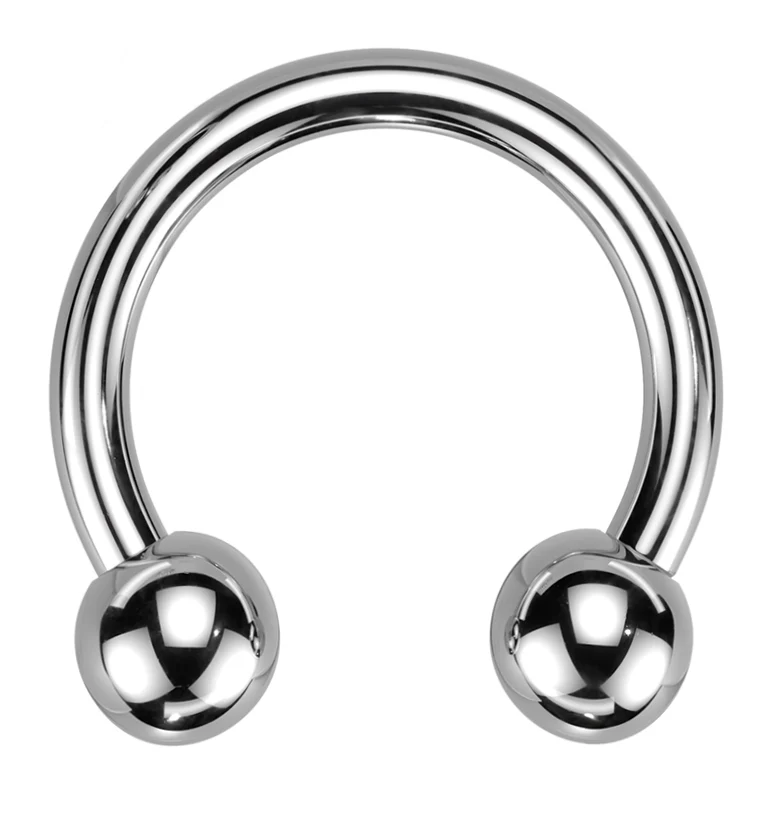
Circular Barbell
Style and Personalization Options
Tongue piercing jewelry offers various customization options to reflect personal style:
Colored Acrylic Balls: Lightweight and available in numerous colors, allowing for vibrant personalization. Jedoch, they may be less durable than metal options.
Glow-in-the-Dark Options: Ideal for making a statement, especially in low-light settings.
Jeweled Ends: Add a touch of elegance and sparkle to the piercing.
When selecting decorative elements, prioritize high-polish, biocompatible materials to avoid irritation and ensure oral health.
IV. Materielle Angelegenheiten: Best Metals for Tongue Piercings
The choice of material for tongue piercing jewelry is paramount due to the tongue’s constant movement and proximity to teeth and gums. Materials must be non-toxic, korrosionsbeständig, and biocompatible to prevent allergic reactions and ensure longevity.
Top Materials for Tongue Piercing Jewelry
Titan-Qualität-Titan (ASTM F-136):
Benefits: Leicht, highly corrosion-resistant, und hypoallergen, making it ideal for individuals with metal sensitivities. Its biocompatibility ensures minimal risk of adverse reactions.
Verwendung: Perfect for initial piercings due to its tissue-friendly nature.
316L Surgical Stainless Steel:
Benefits: Durable and biocompatible, though heavier than titanium. It contains trace amounts of nickel, which may not be suitable for those with nickel allergies.
Verwendung: Commonly used in healed piercings where initial sensitivity has subsided.
Bioplast/PTFE (Polytetrafluoroethylene):
Benefits: Flexible, hypoallergen, and safe for dental health. Its flexibility reduces pressure on the piercing and surrounding oral structures.
Verwendung: Suitable for individuals with metal sensitivities or those seeking a softer jewelry option.
Choosing the right material not only enhances comfort but also plays a critical role in the healing process and overall oral health. Consult with a professional piercer to determine the most suitable jewelry type and material based on your anatomy and lifestyle.
V. Tongue Piercing Gauge Sizes Explained
When considering a tongue piercing, understanding the gauge size is essential for both comfort and safety. The term “gauge” refers to the thickness of the jewelry that passes through the piercing.
What Is Gauge Size?
In body jewelry, the gauge number inversely indicates the thickness of the jewelry:
Lower Numbers = Thicker Jewelry: Zum Beispiel, a 14-gauge (14G) barbell is thicker than a 16-gauge (16G) one.
This sizing system is crucial because the gauge affects the healing process and the overall comfort of the piercing. Using a gauge that’s too thin might lead to migration or rejection, while one that’s too thick can cause unnecessary trauma during insertion.
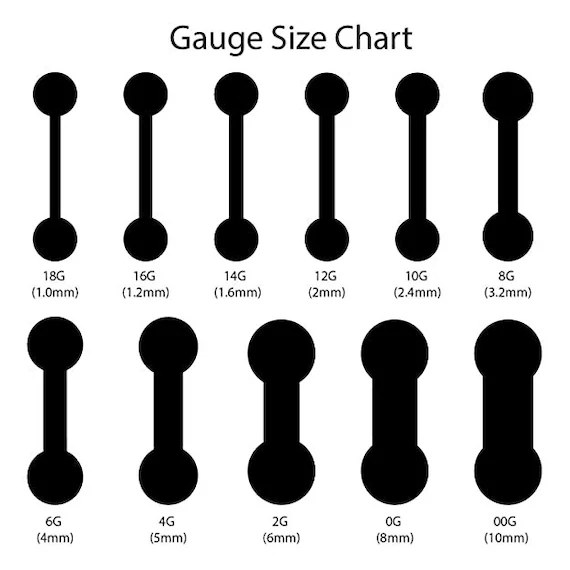
Common Gauge Sizes for Tongue Piercings
The standard gauge for tongue piercings is typically:
14G (1.6mm): This size balances durability and comfort, making it the most commonly used.
Jedoch, some individuals may opt for alternative sizes based on personal preference or anatomical considerations:
12G (2.0mm): Slightly thicker, chosen by those seeking a more substantial feel or appearance.
16G (1.2mm): Thinner than the standard, though less commonly used for initial piercings.
It’s essential to consult with a professional piercer to determine the most suitable gauge size for your anatomy and lifestyle.
Changing Jewelry Gauge
After the initial healing period, some individuals consider changing the gauge of their tongue jewelry:
Downsizing: Once swelling subsides, it’s common to switch to a shorter barbell of the same gauge to reduce movement and minimize the risk of dental damage.
Stretching: Increasing the gauge size (making the hole larger) is possible but should be approached with caution. Stretching should be done gradually and under the guidance of an experienced piercer to prevent tissue damage.
Making informed decisions about gauge sizes ensures the longevity and health of your tongue piercing.
VI. How Poor-Quality Jewelry Affects Oral Health
Selecting high-quality jewelry for tongue piercings is not merely an aesthetic choice but a critical factor in maintaining oral health. Inferior jewelry can lead to several complications.
Potential Complications
Dental Damage: Jewelry made from subpar materials or with rough surfaces can cause chipped or cracked teeth, especially if the jewelry is large or improperly fitted.
Gum Recession: Continuous contact between the jewelry and gum tissue can lead to gum recession, exposing tooth roots and increasing sensitivity.
Infektionen: Non-sterile or allergenic materials can introduce bacteria into the piercing site, leading to infections that may have systemic implications if untreated.
Benefits of High-Quality Jewelry
Investing in superior jewelry offers several advantages:
Smooth Surface: High-quality jewelry typically has a polished finish, reducing friction against teeth and gums, thereby minimizing irritation.
Hypoallergenic Materials: Materials like implant-grade titanium or surgical stainless steel are less likely to cause allergic reactions, promoting better healing and comfort.
Haltbarkeit: Quality jewelry is less prone to tarnishing or degradation, ensuring longevity and reducing the need for frequent replacements.
Why Certified Materials Matter
Zu erfassen, we prioritize your health by ensuring that all our tongue piercing jewelry complies with international safety standards. Our products are crafted from certified materials, undergo third-party testing, and have traceable sources. This commitment guarantees that you’re adorning your body with jewelry that’s both beautiful and safe.
For a comprehensive selection of our high-quality tongue piercing jewelry, visit our product page.
By choosing reputable jewelry from trusted providers like Sensagem, you safeguard your oral health while expressing your unique style.
VII. Choosing the Right Jewelry Supplier
For piercing studios, importers, and brands, selecting a reliable jewelry supplier is crucial to ensure product quality, Sicherheit, and customer satisfaction. Key factors to consider include:
Consistency: A dependable supplier should consistently deliver products that meet established quality standards, ensuring uniformity across all items.
Certifications: Suppliers with recognized certifications demonstrate adherence to international safety and quality benchmarks, reflecting their commitment to excellence.
Anpassung: The ability to offer OEM (Original Equipment Manufacturer) and ODM (Original Design Manufacturer) services allows brands to provide unique, tailored products that align with their identity and meet specific market demands.
What Makes Sensagem Different
Sensagem distinguishes itself in the body jewelry market through several key attributes:
In-House Manufacturing with Strict Quality Control: By overseeing the entire production process internally, Sensagem maintains rigorous quality control measures, ensuring each piece of jewelry meets their high standards.
International Certifications: Sensagem’s products comply with international standards, einschließlich ASTM F136-Zertifizierung für Titan und Hypoallergenitätsgarantien für 316L-Chirurgiestahl, underscoring their commitment to safety and quality.
OEM & ODM Services: Sensagem offers flexible customization options, enabling brands to develop unique designs that resonate with their target audience.
Global Distributor Support: With efficient production processes and a commitment to timely delivery, Sensagem supports distributors worldwide, ensuring fast turnaround times and responsive customer service.
By partnering with Sensagem, businesses can confidently offer their customers high-quality, sicher, and stylish tongue piercing jewelry.
VIII. Abschluss
Understanding the various aspects of tongue piercings—including types, jewelry materials, and gauge sizes—is essential for both enthusiasts and professionals. Recognizing the health risks associated with low-quality jewelry highlights the importance of selecting high-grade options to ensure safety and comfort.
For piercing studios, Einzelhändler, and importers, collaborating with certified suppliers like Sensagem guarantees access to premium products that meet international standards. This partnership not only enhances customer satisfaction but also upholds the integrity and reputation of the business.
To explore Sensagem’s range of tongue piercing jewelry and learn more about their services, visit our product page.
